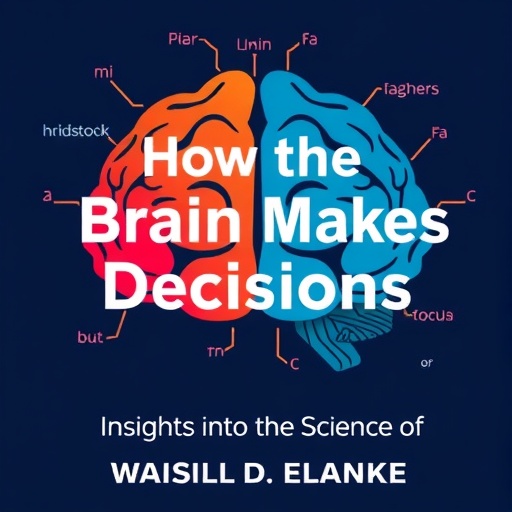
In the intricate labyrinth of neural activity that defines decision-making, our brain often encounters moments where indirect relationships between sensory stimuli shape our choices. While direct associations between environmental cues and outcomes have traditionally dominated neuroscientific paradigms, recent groundbreaking research reveals how the brain weaves together seemingly unrelated events to guide behavior. A pioneering study conducted by the Cellular Mechanisms in Physiological and Pathological Behavior Research Group at the Hospital del Mar Research Institute sheds light on the neural substrates that enable this complex cognitive feat. Their findings, published in the prestigious Proceedings of the National Academy of Sciences (PNAS), unpack the architecture of brain circuits responsible for encoding indirect sensory associations, fundamentally advancing our understanding of decision-making processes.
This investigation, spearheaded by first author and doctoral student José Antonio González Parra under the mentorship of Dr. Arnau Busquets, employed a sophisticated combination of behavioral paradigms and cutting-edge genetic tools in murine models. The team designed experiments where mice were trained to create associative links not just between stimuli and outcomes but also between stimuli themselves, which, from the outset, appeared to bear no obvious connection. For example, mice learned to pair distinct olfactory cues—banana and almond smells—with particular gustatory experiences, such as sweetness and saltiness respectively. Crucially, subsequent aversive stimulus conditioning was applied solely to the banana odor, testing whether the negative valence would transfer to the sweet taste because of the indirect association formed through the odor-taste interplay.
The results were remarkable and demonstrated the brain’s capacity to encode and retrieve indirect associations proficiently. After conditioning the aversive response to the banana smell, the mice exhibited rejection behavior not only towards the smell but also towards the sweet taste linked indirectly through that scent. This behavioral shift highlights the brain’s ability to extend learned negative valence across sensory modalities, mediated by association networks rather than simple one-to-one pairings. As Dr. Busquets succinctly articulates, the animals “formed an indirect association between the sweet taste and the aversive stimulus through its link to a specific smell,” a phenomenon that underscores a sophisticated level of associative cognition previously underexplored.
.adsslot_ptA9QxcRmV{width:728px !important;height:90px !important;}
@media(max-width:1199px){ .adsslot_ptA9QxcRmV{width:468px !important;height:60px !important;}
}
@media(max-width:767px){ .adsslot_ptA9QxcRmV{width:320px !important;height:50px !important;}
}
ADVERTISEMENT
To decode the neurobiological mechanisms underpinning this associative complexity, the researchers harnessed genetic manipulation techniques using viral vectors that enabled targeted modulation and visualization of neuronal activity. These tools revealed the centrality of the amygdala—a limbic system epicenter long implicated in emotional processing—in facilitating the encoding and consolidation of such indirect associations. Notably, the lateral entorhinal cortex was also identified as a critical node, projecting neurons directly to the basolateral amygdala. This anatomical linkage appears to mediate the incidental binding of multi-sensory stimuli, effectively serving as a neural bridge that enables cross-modal integration of environmental signals.
Advanced in vivo imaging techniques further delineated the dynamics of these neuronal circuits during associative learning. Real-time activity mapping confirmed a heightened activation of amygdalar neurons during the formation of odor-taste associations. Importantly, the suppression of amygdala activity during conditioning sessions resulted in the abolishment of mice’s ability to form the indirect relationships, cementing the amygdala’s indispensable role in this cognitive process. The data suggests a finely tuned circuit where neural inputs from the entorhinal cortex interface with amygdalar processing units to embed associative memory traces that transcend direct stimulus-outcome frameworks.
These insights have profound implications beyond basic neuroscience, especially in the arena of neuropsychiatric disorders characterized by dysfunctional associative learning—conditions such as post-traumatic stress disorder (PTSD) and psychosis. Aberrant processing of indirect associations, the study posits, may lay the neurological groundwork for symptoms observed in these disorders, including maladaptive fear responses and impaired decision-making. By elucidating the brain circuitry responsible, this research opens new avenues for targeted interventions that modulate the activity of specific regions like the amygdala to recalibrate associative learning pathways in affected patients.
Dr. Busquets emphasizes the translational potential of these findings, highlighting the likelihood that similar neural circuits operate within the human brain given the conserved architecture across mammalian species. This conservation suggests that therapeutic strategies such as non-invasive brain stimulation, optogenetic modulation, or pharmacological manipulation could feasibly be developed to address impairments in indirect association formation. The prospect of restoring or tuning these neural pathways could revolutionize treatment modalities for mental health conditions steeped in cognitive and emotional dysregulation.
Beyond clinical applications, this study challenges existing frameworks within cognitive neuroscience regarding how the brain organizes and prioritizes sensory information when forming memories and decisions. The capacity for indirect association indicates a form of cognitive flexibility that allows organisms to predict outcomes in complex, dynamic environments where cues are often not linearly related. This enriches theoretical models of learning and memory by incorporating multi-layered networks that accommodate indirect, context-dependent associations—a feature vital for adaptive behavior.
At the molecular and cellular levels, the identification of the pathway connecting the lateral entorhinal cortex to the basolateral amygdala adds a crucial piece to the puzzle of how synaptic plasticity in distributed neural circuits enables the encoding of incidental associations. It raises intriguing questions about the signaling molecules, synaptic mechanisms, and gene expression profiles that support such high-order integrative processes. Future research exploring these dimensions could elucidate fundamental principles of neural circuit plasticity and stability in both health and disease.
The methodology employed in this research reflects a sophisticated synergy of behavioral neuroscience, genetic engineering, and functional neuroimaging. Such integrative approaches are essential for dissecting the multifaceted nature of cognition. The use of viral vectors allows for region-specific interventions and observation, enabling researchers to move beyond correlative observations to causative elucidations of neural function. This methodological vanguard paves the way for increasingly precise manipulations to unravel complex brain functions.
In conclusion, this study from the Hospital del Mar Research Institute not only reveals the neural substrates that enable indirect associations between sensory stimuli but also frames these findings within a broader neurobiological and clinical context. By uncovering a neural circuit centered on the amygdala and its projection from the lateral entorhinal cortex, the research delineates how the brain integrates and consolidates multifaceted environmental information to underpin nuanced behavioral responses. These advances not only enhance our fundamental understanding of brain function but also chart a course toward innovative therapies for disorders marked by disrupted associative cognition.
Subject of Research: Neural mechanisms underlying indirect associations between sensory stimuli and their implications for decision-making and mental disorders.
Article Title: Projecting neurons from the lateral entorhinal cortex to the basolateral amygdala mediate the encoding of incidental odor-taste associations
News Publication Date: 6-Jun-2025
Web References: DOI: 10.1073/pnas.2502127122
Keywords: Life sciences, Neuroscience, Neurophysiology, Human brain, Neural pathways, Systems neuroscience, Cell biology, Molecular biology, Cellular neuroscience, Cognitive neuroscience, Neuropharmacology
Tags: associative learning in micebehavioral paradigms in researchbrain circuitry and choicecognitive processes and decision-makingcomplex cognitive behaviorenvironmental cues and behaviorgenetic tools in neuroscienceHospital del Mar Research Institute studyindirect sensory associationsneural substrates of choiceneuroscience of decision-makingPNAS research findings


